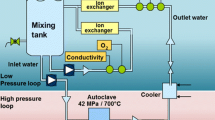Abstract
Two steam explosion experiments were performed in the TROI (Test for Real cOrium Interaction with water) facility by using partially oxidized molten corium (core material), which is produced during a postulated core melt accident in a nuclear reactor. A triggered steam explosion occurred in one case, but none occurred in the other case. The dynamic pressure and the dynamic load measured in the former experiment show a stronger explosion than those performed previously with oxidic corium. Meanwhile, a steam explosion is prohibited when the melt temperature is low, because the melt is easily solidified to prevent a liquid-liquid interaction. The partially oxidized corium could enhance the strength of a steam explosion due to the thermal energy from an exothermic chemical reaction between the water and the uranium metal with a sufficient superheat extracted during melting. The melt composition effect on a steam explosion load, which was not included during the nuclear design, needs to be included in it.
Similar content being viewed by others
References
D. E. Mitchell, M. L. Corradini and W. W. Tarbell, Intermediate scale steam explosion phenomena: Experiments and analysis, SAND81-0124, SNL, USA, (1981).
N. Yamano, Y. Maruyama, T. Kudo, A. Hidaka and J. Sugimoto, Phenomenological studies on meltcoolant interactions in the ALPHA program, Nuclear Engineering and Design, 155 (1995) 369–389.
D. H. Cho, D. R. Armstrong and W. H. Gunther, Experiments on interactions between zirconiumcontaining melt and water, NUREG/CR-5372 (1998).
D. Magallon, I. Huhtiniemi and H. Hohmann, Lessons learnt from FARO/TERMOS corium melt quenching experiments, Nuclear Engineering and Design, 189 (1999) 223–238.
D. Magallon and I. Huhtiniemi, Corium melt quenching tests at low pressure and subcooled water in FARO, Nuclear Engineering and Design, 204 (2001) 369–376.
I. Huhtiniemi, D. Magallon and H. Hohmann, Results of recent KROTOS FCI tests: alumina versus corium melts, Nuclear Engineering and Design, 189 (1999) 379–389.
I. Huhtiniemi and D. Magallon, Insight into steam explosions with corium melts in KROTOS, Nuclear Engineering and Design, 204 (2001) 391–400.
J. H. Song, I. K. Park, Y. J. Chang, Y. S. Shin, J. H. Kim, B. T. Min, S. W. Hong and H. D. Kim, Experiments on the interactions of molten ZrO2 with water using TROI facility, Nuclear Engineering and Design, 213 (2002) 97–110.
J. H. Kim, I. K. Park, B. T. Min, S. W. Hong, J. H. Song and H. D. Kim, An effect of corium composition variations on occurrence of a spontaneous steam explosion in the TROI experiments, Proceedings of NUTHOS-6, Nara, Japan, October 4 ∼ 8 (2004).
J. H. Kim, I. K. Park, B. T. Min, S. W. Hong, H. Y. Kim, J. H. Song and H. D. Kim, Triggered steam explosion experiments in the TROI facility, Proceedings of International Congress on Advanced Nuclear Power Plant (ICAPP’05), Seoul, Korea, May 15–19 (2005).
J. H. Kim, I. K. Park, B. T. Min, S. W. Hong, S. H. Hong, J. H. Song and H. D. Kim, Results of the triggered TROI steam explosion experiments with a narrow interaction vessel, Proceedings of International Congress on Advanced Nuclear Power Plant (ICAPP’06), Reno, NV, USA, June 4–8 (2006).
J. H. Kim, I. K. Park, B. T. Min, S. W. Hong, S. H. Hong, J. H. Song and H. D. Kim, Results of the triggered steam explosions from the TROI experiment, Nuclear Technology, 158(3) (2007) 378–395.
V. Asmolov and V. Strizhov, Overview of the progress in the OECD MASCA project, Cooperative Severe Accident Research Program (CSARP) Meeting, Washington DC, USA (2004).
J. H. Kim, B. T. Min, S. W. Hong, S. H. Hong, I. K. Park, J. H. Song and H. D. Kim, Layer inversion tests with metal-added corium in the TROI experiment, Proceedings of ICAPP’07, Nice, France, May 13–18 (2007).
M. Leskovar, R. Meignen, C. Brayer, M. Burger and M. Buck, Material influence on steam explosion efficiency: state of understanding and modelling capabilities, 2 nd European Review Meeting on Severe Accident Research (ERMSAR-2007), FZK, Germany, June 12–14 (2007).
V. I. Aleksandrov, V. V. Osiko, A. M. Prokhorov and V. M. Tatarntsev, Chapter 6, Synthesis and crystal growth of refractory materials by RF melting in a cold container, Current Topics in Materials Science, Vol. 1, Edited by E. Kaldis, North-Holland Publishing Company (1978).
I. K. Park, J. H. Kim, S. H. Hong, B. T. Min, S. W. Hong, J. H. Song, and H. D. Kim, An investigation of the particle size responses for various fuel-coolant interactions in the TROI experiments, Nuclear Technology, 161 (2008) 45–56.
L. C. Witte, T. J. Vyas and A. A. Gelabert, Heat transfer and fragmentation during molten-metal/water interactions, Journal of Heat Transfer, 95(4) (1973) 521–527.
J. H. Song, B. T. Min, B. T. and F. Defoort, The effect of a material composition on the strength of a prototypic steam explosion, Proceedings of NTHAS5, Jeju, Korea, Nov. 26–29 (2006).
Author information
Authors and Affiliations
Corresponding author
Additional information
This paper was recommended for publication in revised form by Associate Editor Jae Young Lee
Jong-Hwan Kim is a principal researcher at Thermal Hydraulics Safety Research Division at Korea Atomic Energy Research Institute (KAERI). He received B.Sc. and M.Sc. degrees with nuclear engineering from Seoul National University in the Republic of Korea and a Ph.D. degree with film boiling heat transfer in 1994 from the University of Manchester in the United Kingdom. Thereafter, he has been working on the safety research for the severe accidents at nuclear power plants, especially fuelcoolant interactions.
Rights and permissions
About this article
Cite this article
Kim, J.H., Min, B.T., Park, I.K. et al. Steam explosion experiments using partially oxidized corium. J Mech Sci Technol 22, 2245–2253 (2008). https://doi.org/10.1007/s12206-008-0748-3
Received:
Revised:
Accepted:
Published:
Issue Date:
DOI: https://doi.org/10.1007/s12206-008-0748-3




